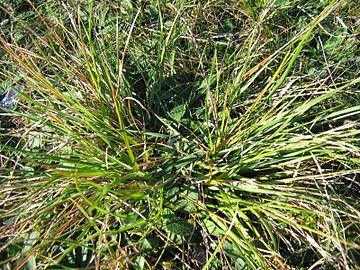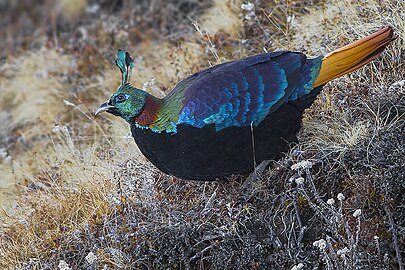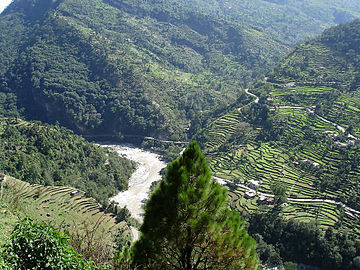Kedarnath Wildlife Sanctuary
Kedarnath Wildlife Sanctuary
केदारनाथ वन्य जीव अभ्यारण | ||
|---|---|---|
Precipitation 3,093 mm (121.8 in) | | |
| Avg. summer temperature | 25 °C (77 °F) | |
| Avg. winter temperature | −10 °C (14 °F) | |
Kedarnath Wild Life Sanctuary, also called the Kedarnath Musk Deer Sanctuary, is a wildlife sanctuary declared under
Located in the Himalayan Highlands with an elevation ranging from 1,160 metres (3,810 ft) (near Phata) to the
The sanctuary straddles a geographically diverse landscape and transitional environment.[4][5] IUCN has reported that "From 44.4% to 48.8% of the sanctuary is forested, 7.7% comprises alpine meadows and scrub, 42.1% is rocky or under permanent snow and 1.5% represents formerly forested areas that have been degraded."[2]
The sanctuary takes its name from the famous
Geography
The sanctuary is geographically situated in the
Religious and social aspect
The sanctuary has a large number of
Climate
A typical
Flora
The sanctuary is reputed to be one of the world's richest bio-reserves.
-
Rhododendrons(Ericaceae)
-
pindrow fir(Also known as West Himalayan Fir)
Fauna
The sanctuary is rich in faunal, avifaunal and aquafaunal species (some are pictured in the gallery).[1][2][8][9][12]
Mammals
- Carnivores are: Indian jackal (Canis aureus indicus), red fox (Vulpes vulpes), Himalayan black bear (Selenarctos thibetanus laniger) (V), yellow-throated marten (Martes flavigula), leopard cat (Felis bengalensis), Indian leopard (Panthera pardus fusca) (V) and snow leopard (Uncia uncia). In June 2019, a tiger was also captured on camera in this sanctuary.[13]
- Hodgsons's brown-toothed shrew (Episoriculus caudatus), red giant flying squirrel (Petaurista petaurista), and Royle's pika(Ochotona roylei).
Birds
Important bird species reported are
Reptiles
Recorded reptile species are
Fish
In the
-
Royle's pika(Ochotona roylei)
-
Himalayan monal(Lophophorus impejanus ♂)
-
Himalayan monal(Lophophorus impejanus ♀)
-
Snow partridge(Lerwa lerwa)
Conservation
Among the more notable of the animals in the region is the animal for which it is alternatively named; the musk deer. Declining population (over 40% in 21 years) of this species and large scale poaching for profit, dictated the decision to declare it as an endangered animal (EN) in 1973 (Halloway, 1973) and the species was listed vulnerable in the red data book of IUCN in 1974. It is found, not only in Uttarakhand in the Himalayan belt up to lowest elevation of 2,500 m (8,200 ft) (within a restricted zone), but also in some parts of the Himalayan belt starting from
The male species of the endangered musk deer in the Kedarnath Wildlife Sanctuary carries the much valued pods
Other scientific activities centered around the sanctuary have been: the high-altitude botanical field station established at Tungnath (3,500 m or 11,500 ft) by the Garhwal University; further ecological studies of the ungulates; WWF on ecology of the Himalayan musk deer and other ungulates near Tungnath, together with surveys of the mammalian fauna and avifauna; and fish fauna studies in the Mandakini River.[2]
Management of sanctuary
The management of the wildlife sanctuary is done by the Uttarakhand Forest department. The Divisional Forest Officer(DFO) Kedarnath Wildlife Division is responsible for scientific management of the wildlife sanctuary as per the approved management plan. The headquarter of Kedarnath Wildlife Division is located at Gopeshwar, District Chamoli. The permission of trekking, camping or conducting scientific study inside the sanctuary is provided by DFO Kedarnath. Wildlife Division. The management of the wildlife sanctuary focuses mainly on wildlife habitat improvement, grazing regulation, forest protection and conservation.
Visitor information
Visitors are mostly Indian nationals on pilgrimage to various temples, though a few international tourists also visit the area. The approach to Kedarnath Temple is only through the sanctuary. Visiting season is from April to June and again from September to November. The number of visitors to the Kedarnath shrine, who passed through the sanctuary, was 5,57,923 in 2007 as against 87,629 in 1987, a quantum jump in 20 years.[2][17]
The nearest airport is at
The sanctuary and surroundings offer some housing for visitors, including the forest hut at Madhyamaheshwar for which prior reservation needs to be done through the DFO, Kedarnath Wildlife Division,
Sanctuary landscape
-
Chaukhamba peak, northern boundary of sanctuary
-
Nanda Devi in reserve forests precincts
-
Sanctuary entry from Chopta
References
- ^ )
- ^ a b c d e f g h i j k l m n o "Kedarnath Sanctuary". UNEP & WCMC. Archived from the original on 18 May 2009. Retrieved 17 July 2009.
- ^ a b c d "Uttarakhand (Uttaranchal)" (PDF). Kedarnath Temple trek. pp. 27 of 43.
- ^ "Uttaranchal SoE November 2004" (PDF). state of the environment. Uttranchal Environment and Pollution Control Board. pp. 15–16. Archived from the original (PDF) on 21 July 2011. Retrieved 18 July 2009.
- ^ "Rudraprayag". Retrieved 18 July 2009.
- ^ a b "Western Himalayan alpine shrub and meadows". Terrestrial Ecoregions. World Wildlife Fund. Retrieved 18 July 2009.
- ^ )
- ^ a b "Kedartnath Sanctuary". Retrieved 18 July 2009.
- ^ )
- ^ a b "Kedarnath Musk Deer Sanctuary - Wild Beauty". Retrieved 18 July 2009.
- ^ Kala, C.P. Conservation Biology, 2005, 19: 368-378http://onlinelibrary.wiley.com/doi/10.1111/j.1523-1739.2005.00602.x/abstract
- )
- ^ Times, Hindustan. "Tiger spotted in Kedarnath at 3,400m altitude".
- ^ a b c "Moschus leucogaster". IUCN Red List of Threatened Species 2009.1. Retrieved 18 July 2009.
- ^ ISBN 978-81-7387-066-8. Retrieved 20 July 2009.
- ^ "Uttaranchal 09". Scribd. Retrieved 20 July 2009.
- ^ "Number Of Pilgrims". Archived from the original on 21 July 2011. Retrieved 20 July 2009.
- ^ "Kedarnath Wildlife Sanctuary". Archived from the original on 27 August 2008. Retrieved 18 July 2009.
- ^ "Kedarnath Wildlife Sanctuary". Archived from the original on 26 July 2011. Retrieved 18 July 2009.










